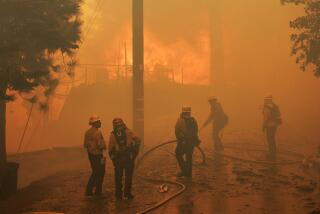Getting Their Goats : Laguna Beach Firefighters Deploy Battalions of Brush-Eaters
LAGUNA BEACH — The city Tuesday unveiled the newest weapon in its arsenal of fire-fighting equipment: a herd of goats.
Goats, 500 of them, are now feasting on the city’s canyon slopes to reduce the threat of brush fires.
Deputy Fire Chief Rich Dewberry, who is in charge of the city’s fuel-break program, said the goats were trucked in Sunday by a private contractor whom the city has hired to conduct a study to determine whether goats can effectively clear a swath of chaparral.
The purpose of pruning back the brush, Dewberry said, is to create a fuel break that will slow a brush fire and reduce its heat so firefighters can more safely put out the flames.
Dewberry said he hopes that the goats will play a major role in helping the city carry out a plan to maintain the existing fuel breaks that protect the northern half of the city and to extend breaks around the southern half.
The City Council has agreed to pay for the $125,000 pilot program to have the goats nibble along three fuel breaks ranging up to 400 feet wide and stretching about four miles. They are expected to complete the task of thinning 152 overgrown acres in about three months.
Dewberry said he believes that Laguna Beach is the only city in Southern California using goats for fire control. Sheep have been used in the backcountry of San Clemente to clear grass before grading, and cattle for many years have controlled undergrowth on the Irvine Ranch.
But sheep and cattle, both of which graze on grass, would go hungry in the canyons of Laguna Beach, which have sparse grass and much woody plant life that is preferred by browsing animals such as goats, Dewberry said.
It is much more common for man, rather than beast, to clear fuel breaks in that terrain. But Laguna Beach fire officials said there is great demand for inmate labor in California, and it would be very costly to hire private crews.
Battalion Chief Joseph L. McClure said goats can prune chaparral for about $600 an acre, while human laborers wielding chain saws and weed cutters frequently charge up to $1,000 an acre.
Goats have other advantages. McClure noted that the last time the city had brush trimmed back, helicopters had to airlift the cuttings to a landfill. With the goats, which clear about 1 acre every one to three days, no leftovers need to be removed.
“They work faster than hand crews, seven days a week and 24 hours a day, and they don’t get poison oak,” noted Ken McWilliam, an animal contractor from Orinda in Contra Costa County, who owns the goats.
McWilliam said the only other jurisdiction that now hires his goats for fire control is the East Bay Regional Park District in the San Francisco Bay Area, but 15 years ago his goats helped the state Department of Parks and Recreation clear brush in the Santa Monica Mountains.
By Tuesday the goats, a bleating crowd of old and young, had already made considerable headway on one section of chaparral just below Skyline Drive, overlooking Laguna Canyon Road. Nude stalks were the only remnants of mustard plants, and chaparral bushes were nothing but clumps of twigs.
McWilliam said the herd includes 13 varieties of goats that have been bred for an ability to eat poisonous plants without being harmed. He said the goats’ chaparral diet is supplemented with alfalfa and water.
Dewberry said the wanderings of the goats will be carefully controlled with the use of electric fences, sheep dogs and herders. The goats will be prevented from consuming protected coastal plants or the habitat of any endangered or threatened species, such as the California gnatcatcher, he said.
Dewberry said a student at UC Irvine plans to study the environmental impact of the goat project.
McWilliam said he believes the goats’ culinary preferences are environmentally sound. “They prune the native plants and get rid of exotics like wild oats, thistles and mustard,” he said.
More to Read
Sign up for Essential California
The most important California stories and recommendations in your inbox every morning.
You may occasionally receive promotional content from the Los Angeles Times.










